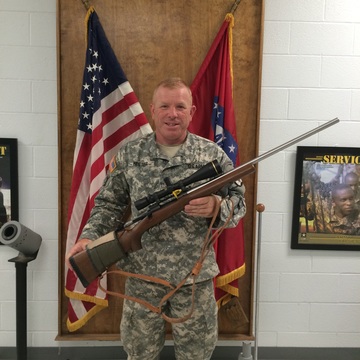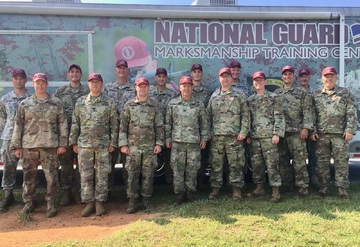
05 Feb Profile in Expertise: There & Back Again With an Army Scout Sniper
This piece is written by Allison Hester, a professional writer and wife to Army Scout Sniper instructor and competitive shooter Mike Hester. In this informative article, she details Mike’s journey through training and the skillset he instills in his trainees as it translates to competitive shooting and hunting.
I met my husband, Mike Hester, back in 1997, shortly after he had moved to Arkansas to teach the Army scout sniper school at Camp Robinson.
At that time, Mike had not officially graduated from sniper school, although he had come really close. You see, in November 1995, Mike attended sniper school and completed over “three weeks of hell” when the government shut down on his last day of class. With the shutdown, everyone who had made it to the end was sent home without graduating. Mike returned home to Nebraska, where he was a tool and die maker in the bullet division for Hornady Manufacturing. Beyond his professional experience, Mike found ballistics fascinating and did a lot of studying on his own.
In 1996, he was invited to come back as a sniper school instructor.
Sniper School – Round 2
Until recently, the scout sniper school was part of the National Guard Marksmanship Training Center, or NGMTC. In March 2000, NGMTC’s machinist position came available and Mike got the job. Since that time, he has built the guns for all the National Guard’s competitive shooting teams. His role has also evolved and he now also travels and competes in multiple pistol and rifle competitions as a member of the All-Guard shooting teams. Mike is distinguished in both pistol and rifle, and was awarded the President’s Hundred in both pistol and rifle as well.
However, not completing sniper school remained a sore spot, so in October 2011 he signed up to do it all again. Keep in mind this was 16 years after his first attempt, and at age 41, he was by far the old man of the group.
Sniper school itself requires tons of physical endurance. The first week, in particularly, is “ridiculously tough.” Mike explained it was “a lot like going through basic training all over again. Smoke session after smoke session.” The school is designed to weed those who don’t really want it. Mike really wanted it.
Early morning day two, Mike and his fellow students had to do “buddy carries” across a dark field. This consisted of running 100 yards while carrying all his own gear, all his “buddy’s” gear, and his buddy over his shoulder. In the process, Mike stepped in a hole and fractured his foot. On top of that, he also came down with a horrible upper respiratory infection. However, he refused to go to sick call until phase 1 was completed for fear of being sent home. And this time, he earned his B-4.
Sniper Training
One misconception is that being a military sniper is mostly about being able to shoot well. While combat snipers must be able to shoot, there’s a lot more that goes into it. “Shooting is actually only about 40% of what snipers do.”
In scout sniper school, there are two components: marksmanship (i.e., shooting) and field craft. It’s the field craft portion that typically sends people home. Field craft includes things such as stalking, target detection, range estimation, KIM’s (Keep in Memory) exercises, and land navigation.
KIM exercises were particularly mentally taxing. “They would place 10 items in a circle, then give you 90 seconds to remember everything you could about them. What they looked like. What shape. What color. All the while, the instructors are yelling, honking horns, and throwing water on you to distract you.” Then sometime later – whether it was 10 minutes or 2 days – the students would have a surprise exam on remembering details about the items.
Additionally, the ballistics and range estimation aspects required a lot of math. “While most of the guys could do the math under regular classroom circumstances, you had to do it in the field. Everything about the program was fast and furious and you were so tired. It made it really stressful.”
That’s why not everyone passes the course. Back when Mike went through the class in 1995, about 40% graduated.
Applying Sniper Training to Hunting and Competitive Shooting
While most people who go through scout sniper school will never actually use the training in combat, there are a number of skills and principles that have practical applications for hunting and competitive shooting.
1. Target Detection
The key to target detection is to learn how to slow down and systematically scan near to far and left to right. This teaches you how to pick out pieces of a target instead of looking for the whole target. “When hunting rabbits in briars, you don’t look for a rabbit, you look for the black dot that’s the eyeball,” he explained. “The camouflage, whether it’s with animals or the enemy, is so stellar that you can’t see them completely. You have to look for small shapes that are parts of their bodies.” Similarly, you likely won’t be able to see a sniper, so you look for the black dot that’s the end of their muzzle, etc.
2. Stalking Skills
These teach you how to see and not be seen, which is a fundamental aspect of hunting. “The key to the kingdom is to have two layers of vegetation between you and the target. One close to the target and one close to you.” This helps obscure the target’s ability to see you.
3. Range Estimation
Expensive sniper scopes will have mil dots or mil rad stadia lines for range estimating capabilities, “but even the cheapest hunting scopes with a duplex reticle can be used to estimate range. The most reliable way to find range is with a laser range finder, and with the low cost and high reliability of these tools, it’s a smart investment, especially compared to the cost of a failed hunt due to poor range estimation.”
4. Wind Calls
When you’re shooting at 500+ yards, being able to calculate the effect of the wind on your bullet is extremely important. One thing is to recognize is the farther your bullet goes down range, the more energy it loses. Also the further you’re shooting, the greater the wind effect. “If you don’t know how to account for wind, you’ll miss your long-range target.”
Mike’s recommendation is to find a good ballistic calculator and plug in the numbers for the velocity, weight of your bullet, and the BC (ballistic coefficient), and the range you want to zero your rifle at, then print out the ballistic table, go to the range, and actually shoot with those conditions to make sure it reflects reality. These calculators can be found online.
Additionally, Mike referred to the four fundamentals of marksmanship:
Sight Alignment – If your sights are crooked one way or the other, your bullet will go one way or the other.
Sight Picture – Where your sights are in relation to the target. You need to know where the best place is to put a bullet in order to make the kill.
Breathing – Shots are generally made during natural respiratory pause. When you naturally exhale without forcing air out, you pause before you inhale for the next breath. That is the natural respiratory pause.
Trigger control – This is the ability to press the trigger straight to the rear until it breaks the shot without disturbing your sight alignment or sight picture. Mike stresses doing dry firing drills – i.e., dry firing against a dot on the wall. “You are able to catch yourself moving more during dry firing than you do when you’re actually shooting ammo.”
Beyond all of this, Mike stresses that the second most important thing is to practice. The most important thing is to practice correctly.
“You can read, you can theorize, but you have to actually correctly apply what you learn in order to shoot and hunt better. A lot of very high-quality training can be had without having to shoot a lot of rounds as long as you do it right.”
Allison Hester is a professional freelance writer and the publisher of eClean Magazine. She and her husband, Michael, just celebrated 21 years of marriage.





No Comments